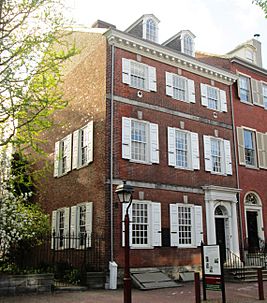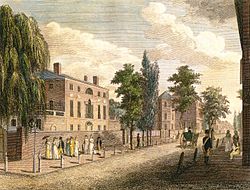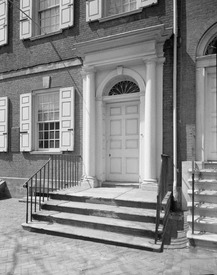Powel House facts for kids

(2013)
|
|
| Location | 244 S. Third St. Philadelphia, Pennsylvania |
|---|---|
| Type | house museum |
| Public transit access | |
The Powel House is a famous old house in Philadelphia, Pennsylvania. It is located at 244 South 3rd Street. This historic building was built in 1765. It was designed in the Georgian style.
The house became even more beautiful when Samuel Powel bought it. He was the second owner. Many people call it "the finest Georgian row house in the city." From the outside, the house looks simple. But inside, it was decorated with amazing details.
Contents
History of the Powel House
Early Owners and Samuel Powel
This elegant brick house was first built for Charles Stedman. He was a merchant and ship captain. But before he could live there, Stedman faced money problems. He even ended up in a debtors' prison. This was a place where people who owed money were kept.
Samuel Powel bought the house on August 2, 1769. He paid £3,150 for it. Samuel Powel was a very important person. He was the last mayor of Philadelphia when the British still ruled. After America became independent, he became the city's first mayor.
Powel was born a Quaker, a religious group. Later, he became an Anglican, another Christian group. He strongly supported the American Revolution. Because of his support, people called him the "Patriot Mayor."

Designing and Decorating the House
Many people believe that Robert Smith designed the Powel House. He was a well-known architect and builder. Samuel Powel and his wife, Elizabeth, spent a lot of money decorating their new home. They created some of the most fancy interiors in all the American Colonies.
The beautiful plastered ceilings were made in the Rococo style. They are thought to be the work of James Clow. The detailed wooden parts of the house were likely carved by Hercules Courtnay and Martin Jugiez.
Famous Guests and Changes to the House
The Powel House shared a wall with the house next door. This was the home of Governor John Penn. During the Revolutionary War, the governor's house was taken by the government. George and Martha Washington lived there for several months. This was after the American victory at Yorktown in October 1781.
The Powels often entertained important guests. They hosted the Washingtons, and other famous people. These guests included Benjamin Franklin, John Adams, Benjamin Rush, and the Marquis de Lafayette.
Philadelphia was the temporary capital of the United States from 1790 to 1800. President Washington lived in a house on Market Street for over six years. Before he moved in, he added a special "Bow Window" to his house. This was a two-story, curved addition. It made his dining room and drawing room bigger.
The Powels might have been inspired by this. They added a three-story, half-turret to their own house. A half-turret is like a bay window, but it's curved on the inside. This addition made their back parlors and a bedroom larger. It also added more windows looking out to the garden. You can see this half-turret in old pictures from 1799 and 1817. Later, in the mid-1800s, this addition was removed.
After Samuel Powel's Death
Samuel Powel died in 1793. This was during a terrible yellow fever epidemic in Philadelphia. About 10% of the city's people died from the disease.
In early 1797, Mrs. Powel bought several items from President Washington. He was about to leave office. These items included his presidential coach and horses. She also bought his presidential desk and a pair of fancy mirrors.
Elizabeth Willing Powel sold the house in November 1798. She sold it to William Bingham. He was married to her niece, Ann Willing Bingham.
The Marquis de Lafayette gave the Powels a set of china. This china is now on display at the Powel House. There is also a portrait of Mrs. Powel from 1793. It is on loan from the Pennsylvania Academy of the Fine Arts.
Saving the Powel House from Demolition
In the early 1900s, the house was used as a warehouse. It stored horse hair and bristles from Russia and Siberia. In 1918, the owners sold some of the house's beautiful woodwork. The woodwork from the second-floor parlor was sold to the Metropolitan Museum of Art. It is now part of a special "period room" there. In 1925, the ballroom's plaster ceiling and woodwork were sold to the Philadelphia Museum of Art.
By 1930, the Powel House was going to be torn down. The plan was to turn the property into a parking lot.
But a woman named Frances Wister saved the house. She loved old things and history. In 1931, she started the Philadelphia Society for the Preservation of Landmarks. This group raised money to buy the house. Over the next ten years, Wister and her group worked hard. They bought and tore down a building that covered part of the garden. They also hired an architect, H. Louis Duhring Jr.. His job was to restore the house to how it looked when the Powels lived there. He also recreated the lost interior rooms.
The Society opened the restored house as a museum. It helps people learn about the daily lives of rich Philadelphians during the American Revolution.
Today, you can see the rich history of the Powel House. It has a collection of decorative art and portraits of the Powel and Willing families. It also has a formal, walled garden, typical of old Philadelphia. The house is known for its beautiful entryway, ballroom with detailed plasterwork, and mahogany wood panels. These features give it a reputation as one of America's finest old Georgian townhouses.
It has been said that the house might be haunted by the ghost of Peggy Shippen. She was Elizabeth Powel's second cousin and the wife of Benedict Arnold.
Gallery
See also






